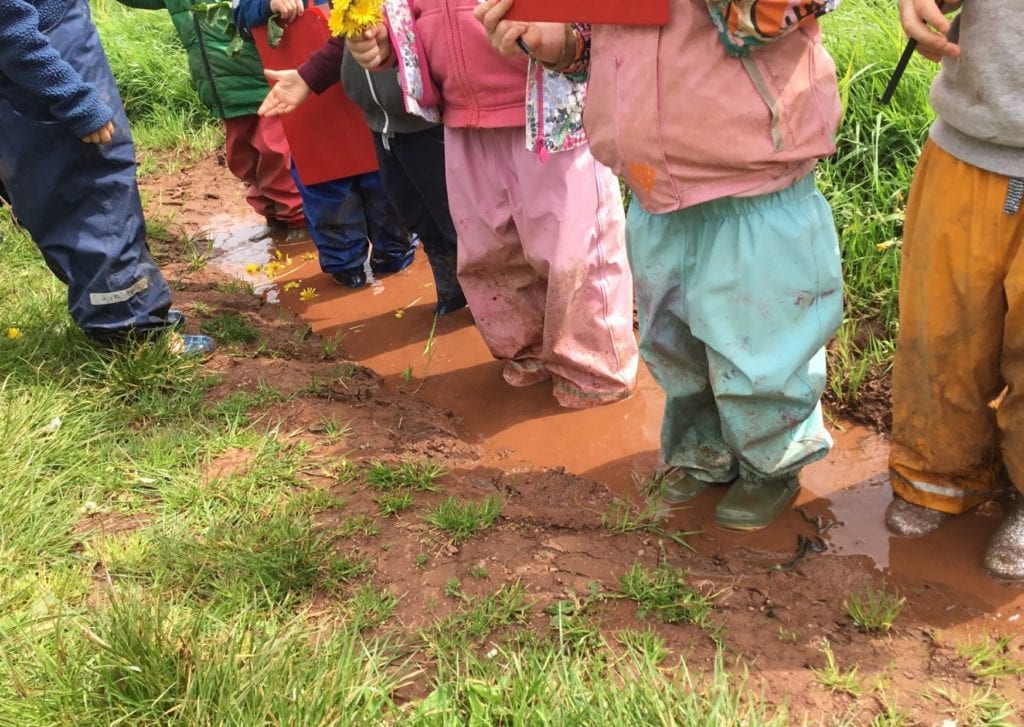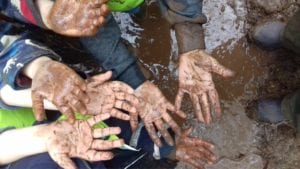
There really is a day for everything and as it so happens, today is International Mud Day!
As you can imagine, here at The Outdoors Group, we are big on mud. To be honest, when there’s so much of it around, if the choice is to moan about it or to embrace it, we’d always go for the latter.
Admittedly, it feels a little bittersweet writing about a day to celebrate mud during a time when our forest schools are still closed. However, I thought we could dive in and have a look at what it is about mud that irresistibly attracts children of all ages. It’s a washing machine’s most dreaded invitation to play!

The main reason I think kids are drawn to mud (even when it’s the only patch in a 5 acre wood!), is simply for the sensory experience. They love jumping into it, the squelching sound of wading through it, the feeling of it between their hands as they made mud pies. They love it when it’s wet and almost liquid, when it’s mouldable like clay, when it’s warm from the summer sun or cool in the spring and autumn months. They love breaking the ice in winter to reveal the mud underneath and the edges of small brooks and streams, surrounded by the delicious stuff. If you can get over your desire to stay clean and join in, I think you’ll be surprised by how enjoyable you find the sensations as well!

And luckily for kids, playing in mud is actually good for them! Scientists have shown that ‘dirt contains microscopic bacteria called Mycobacterium Vaccae which stimulates the immune system and increases the levels of serotonin in our brains…scientists say regular exposure to the bacteria may help reduce a child’s vulnerability to depression’ (1). So whilst you might shudder inside as your child approaches that muddy puddle, they’re actually seeking out something that will make them happier!
Additionally, there is an argument that in our over-sanitised world, a lack of exposure to germs can be detrimental to children’s health, contributing to the rise in allergies and asthma that children often suffer from. By exposing children to dirt and mud, we could be keeping their immune systems stronger and healthier (just don’t forget to make them wash their hands before they eat).

The great thing about mud is that the potential for play is enormous. One of the most popular areas of all our Forest School sites is the mud kitchen. These don’t have to be fancy, painted and beautifully crafted stations. You can make one yourselves with some discarded pallets or old furniture in your back garden. Add in some pots and pans that have lost their non-stick coating or that you’ve sourced from the charity shop and you’re ready to go. Toddlers in particular are prone to spending hours creating you the most elaborate mud-based meals you’ll ever have the good fortune to dine on!
Older children often like using mud to express their creativity, whether that’s painting with the sloppiest stuff or using the drier mud to sculpt amazing models. You’ll be amazed at what they can create when given a free rein.
Mud really is full of open-ended possibilities when it comes to play, roll it into balls to throw (not at people!), add some trucks and make a building site, introduce toy animals and other woodland materials to make dens…the list goes on and on.

However, even though I logically know the benefits of letting my kids go hell for leather when it comes to playing in my mud, I won’t lie. My heart does sink when they come stomping out of the forest, covered head to toe (including, quite often, deliberate mud war paint on their cheeks and in their hair) in wet, slimy mud. Over 6 years of Forest School attendance, I’ve finally picked up a few tips on how best to leave the mud in the woods when you leave.

Happy International Mud Day folks – we’ve had some rain recently so why not suit up and find a patch to celebrate in today!
Author: Hannah Durdin
Date: Monday 29th June 2020
Copyright © Outdoors Group Ltd 2021. All Rights Reserved.
Registered Office: The Outdoors Group, Western Lodge, Crediton, Devon, EX17 3NH. Company number 10755829
Terms & Conditions / Website Terms / Privacy Policy / Sitemap / Built with ♥ by Solve
2 responses
Great article Hannah,
I have to say growing up I spent most of my time in puddles of mud and water. They’re definitely easy to find in the UK with how much rain we always seem to get! I can’t think of a moment where I was unhappy while covered in mud, whether it be in a field or when playing football or rugby. I really think there are health benefits to it as well, helping to build a strong immune system.
I look forward to reading more, keep up the great work.
Thanks Tim! Yes, I think the same…trail running often has resulted in me being knee deep in mud but I never regret it, nothing a wash can’t sort. Thanks for taking the time to read and comment 🙂